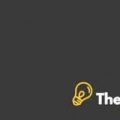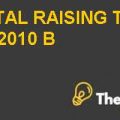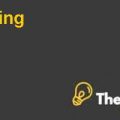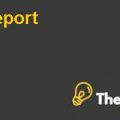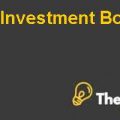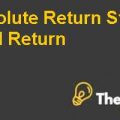
Effects of Adding $1 Billion of Debt on Various Ratios and the Implied Credit Rating
EBIT Interest Coverage
However, the addition of $1 billion will decrease the interest coverage ratio,because the increase of $1 billion revenue will increase the interest cost, meanwhile, the EBIT has been assumed to be constant as before. However, due to the increase in interest expense the interest coverage ratio will dramatically decline from 101.5 times to 10.07 times, which might expose UST to the financial risk of not meeting the interest commitments in case if the EBIT declines by a certain percentage. Further, the additional loan will decline the rating of UST from AAA to AA, which means that UST will have to pay 5.84% of yields on its 10 year loan.
EBITDA Interest Coverage
Additionally, the interest coverage ratio calculated through the available operating cash equivalent EBITDA, will also decline significantly and its ratings will decline to AA.
Fund Flow/Total Debt
Meanwhile, the fund flow as the percentage of total debt will also decline significantly. The further decline in this percentage is partly due to the decline in fund flows left after in the increase interest payments made on the additional loan of $1 billionand partly due to the increase total debts. Therefore, this double effect has largely affected this ratio. However, the interest rate has been applied equal the interest rate on the previously held debts. Meanwhile, UST rating will decline from AAA to BB and the estimated interest rate for its ten year loan would be 7.70%.
Free Operating Cash Flow/Total Debt
The free cash flow to total debt ratio will also decline remarkably.However, the decline in this ratio is lower than the decline in fund flow to total debt ratio, because the fund flow excludes the interest payments and hence it the increased interest payments will reduce the available fund flows. Meanwhile, the decline free operating cash flows are based on the operational cash flows and do not incorporate additional interest expense. Therefore, the additional $1 billion loan will bring this ratio almost equal to the fund flow to debt ratio, which was previously quite higher than the fund flow to total debt ratio. Additionally, the credit ratings of UST will fall to AA and its expected cost of new loan capital would be 5.84%.
Return on Capital
, the return on capital ratio has also significantly declined, further, the return will increase because the returns are calculated using the EBIT plus interest expense, therefore, the additional interest expense will be added into the current EBIT. Meanwhile, the total capital will increase by the additional loan of $1 billion. However, since the EBIT will only increase by the interest amount, whereas, the total capital will increase by the additional loan amount. Therefore, the net effect will decrease the return on capital generated by UST;however, its credit rating will not change and will remain at AAA.
Operating Income/Sales
However, the operating income to sale ratio, neither incorporate interest nor the loan amount, because the operational income is generated through business operations and interest payments will be an outflow not controlled by the business operations. Therefore, the additional loan of $1 billion or the resultant interest expense will not alter the operation income to sales ratio; meanwhile, the credit rate will also remain at the same level of AAA rating.
Total Debt/Capital
Meanwhile, the total debt to total capitalization ratio will also be largely affected due to the additional loan of $1 billion, hence, this ratio will significantly deter UST leverage position because the portion of the equity will become around 25% of the total capitalization. However, the high leverage might put UST into financial difficulties and UST may face bankruptcy proceedings if profits reduce below the level that it cannot meet its interest payment commitments. However, due to the significantly higher level of leverage ratio its credit rating will fall from AAA to CCC, which will increase its borrowing cost to more than 11.19%.
Long-term Debt/Capital
Furthermore, the additional loan will increase the long term debts and total capitalization, therefore, the long term debt to total capitalization ratio will also increase significantly. Hence, the ratio will become 71.11%, which is currently, 18.29%. Similarly, the credit rating of UST will become B and its cost of capital will be higher than 11.19%.
Valuation of UST through APV
However, the adjusted present value method has been used in order to calculate the net present value of the business. However, in order to calculate the adjusted present value of the company, a ten year projection of future cash flows has been prepared. Further, the after tax EBITDA has been as the basis for calculating the future projected cash flows of UST, additionally, the EBITDA has been grown at the 10 year average growth rate as calculated in the.....................
This is just a sample partial case solution. Please place the order on the website to order your own originally done case solution.

